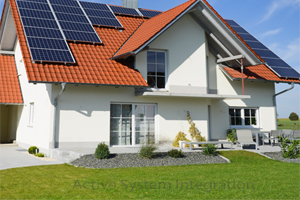
Solar panel electricity systems, also known as solar photovoltaics (PV), capture the sun's energy using photovoltaic cells. These cells don't need direct sunlight to work – they can still generate some electricity on a cloudy day. The cells convert the sunlight into electricity, which can be used to run household appliances and lighting.
The benefits of solar electricity
Cut your electricity bills
sunlight is free, so once you've paid for the initial installation your electricity costs will be reduced.Get paid for the electricity you generate
the government’s Feed-In Tariffs pay you for the electricity you generate, even if you use it.Sell electricity back to the grid
if your system is producing more electricity than you need, or when you can't use it, you can sell the surplus back to the grid.Cut your carbon footprint
solar electricity is green, renewables energy and doesn't release any harmful carbon dioxide] or other pollutants. A typical home solar PV system could save over a tonne of carbon dioxide per year – that's more than 30 tonnes over its lifetime
How do solar panels (PV) cells work?
PV cells are made from layers of semi-conducting material, usually silicon. When light shines on the cell it creates an electric field across the layers. The stronger the sunshine, the more electricity is produced. Groups of cells are mounted together in panels or modules that can be mounted on your roof.

The power of a PV cell is measured in kilowatts peak (kWp). That's the rate at which it generates energy at peak performance in full direct sunlight during the summer. PV cells come in a variety of shapes and sizes. Most PV systems are made up of panels that fit on top of an existing roof, but you can also fit solar tiles.
Solar tiles and slates
Solar tiles are designed to be used in place of ordinary roof tiles. A system made up of solar tiles will typically cost around twice as much as an equivalent panel system, although you will save the money you would have spent on roof tiles or slates. Solar tile systems are not normally as cost-effective as panel systems, and are usually only considered where panels are not considered appropriate for aesthetic or planning reasons.
Maintenance
Solar PV needs little maintenance – you'll just need to keep the panels relatively clean and make sure trees don't begin to overshadow them. In the UK panels that are tilted at 15° or more have the additional benefit of being cleaned by rainfall to ensure optimal performance. Debris is more likely to accumulate if you have ground mounted panels.
If dust, debris, snow or bird droppings are a problem they should be removed with warm water (and perhaps some washing-up liquid or something similar – your installer can advise) and a brush or a high pressure hose (or telescopic cleaning pole) if the panels are difficult to reach. Always be careful if you are working above the ground or near the top of a ladder. Alternatively, there are a number of specialist window cleaning companies who will clean solar PV panels for you at a cost (of around £30 based on our research in March 2012) depending on the size of your array and location. Many of these companies use a water fed pole system which does away with the need for a ladder.
Once fitted, your installer should leave written details of any maintenance checks that you should carry out from time to time to ensure everything is working properly. This should include details of the main inverter fault signals and key trouble-shooting guidance. Ideally your installer should demonstrate this to you at the point of handover. Keeping a close eye on your system and the amount of electricity it’s generating (alongside the weather conditions) will familiarise you with what to expect and alert you to when something might be wrong.